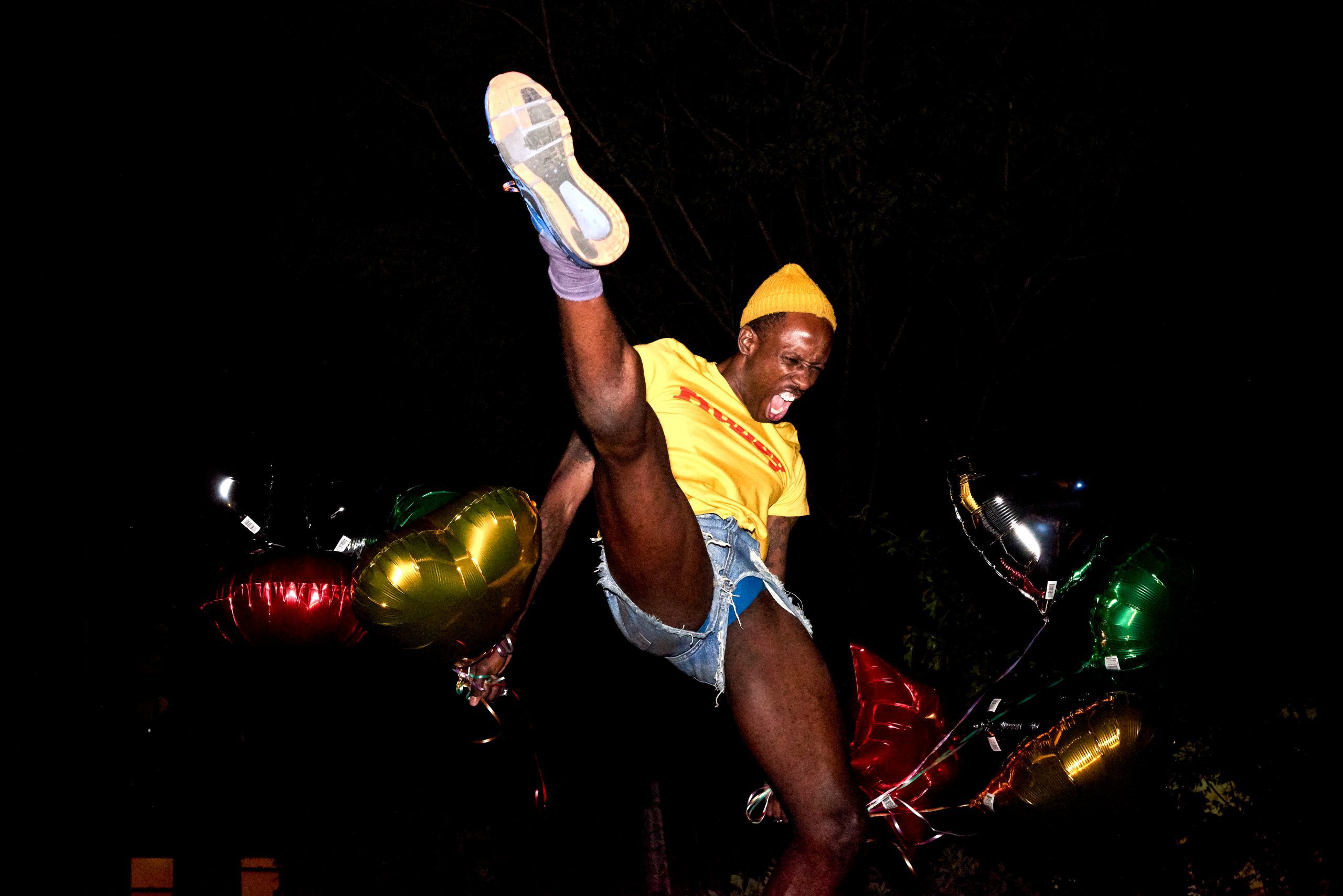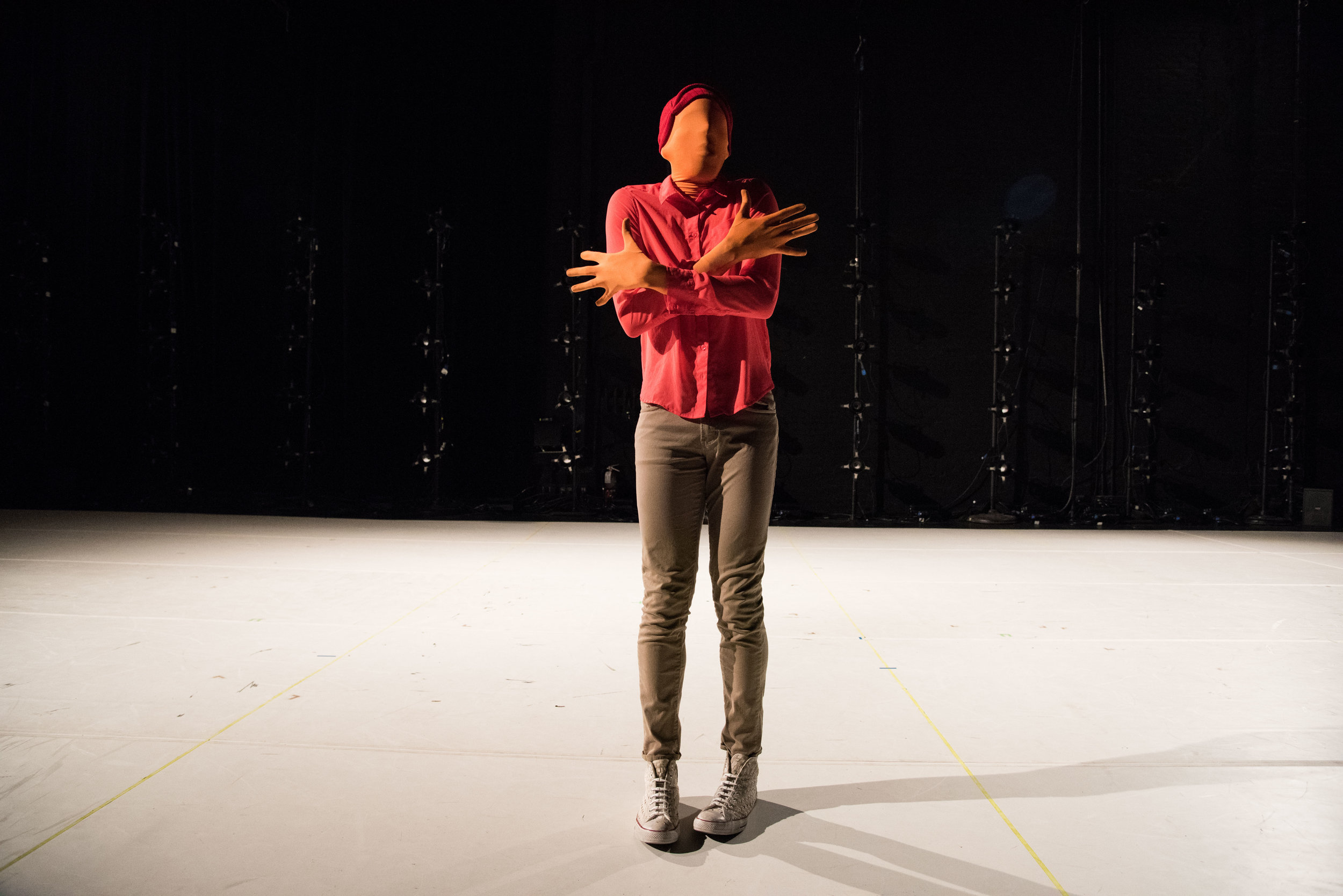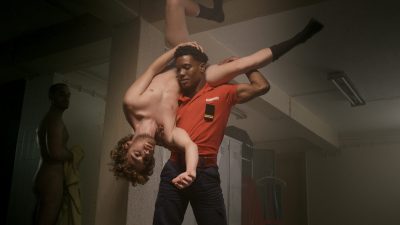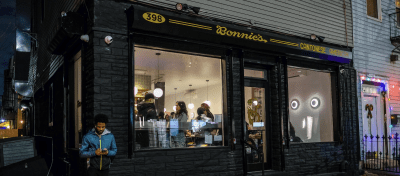Photo by Jayme Thornton
On the move with Raja Feather Kelly
Meet the choreographer who is changing what can be done on stage, one subtle movement at a time
Raja Feather Kelly breezes into my apartment dressed in a black leather jacket, mismatched socks and his omnipresent wool beanie. He plops himself down facing the Andy Warhol cow lithograph on my dining room wall. He’s come bearing his own Warhol: The famous banana is stenciled onto his sweatshirt and flashes from under his jacket.
“He understood it better than anyone else,” Kelly says of Warhol. “It only seems fitting to be fascinated.”
Of course Kelly—who isn’t here to talk about Warhol (though we will get to that)—is an object of fascination in his own right. He has come to talk about the arc of his career, which has gone from producing pop-queer productions with his Brooklyn-based company, the feathr3r theory, to becoming New York’s hottest dancer, director, multimedia artist and, per The New York Times, “go-to choreographer.”
Kelly is everywhere. On his current plate are not one, but two world premieres that he has choreographed: “On Sugarland,”
by Obie Award-winner Aleshea Harris, which began previews February 2 at the New York Theater Workshop, and “Suffs,” an ambitious new musical opening March 13 at the Public Theater and running through May 1.
“A Strange Loop,” the Pulitzer Prize-winning play by Michael R. Jackson that Kelly choreographed in 2019, is heading for Broadway later this year. He’s also providing his talents to “Lempicka,” a new musical biography about the life of acclaimed artist Tamara de Lempicka, coming to the La Jolla Playhouse in its 2022-23 season.
In a literal sense Kelly’s job sounds simple: He interprets the text and tells the actors how to move in ways that evoke emotion when words—or music—alone won’t do. It’s not just musicals that require choreography, after all.
Take Harris’ “On Sugarland.” The raw, intense, 14-character drama about survival is rooted in both the physical and spiritual. The story focuses on each character’s ritual for thriving, despite generational trauma and the looming specter of an unending war.
“On Sugarland” is what Kelly calls “a surreal examination of what brings Black communities together, and what could potentially tear them apart.”
Set in a small, fictitious neighborhood somewhere in the South, three trailers are parked at a cul-de-sac, each packed with decades of folk art treasures, memories and hope for a vibrant future.
“Raja really understands the context of the play and the context of the characters,” says Harris, who calls him an adventurous collaborator.
“He doesn’t just come in and give the actors movement for movement’s sake. He is really good at building up and figuring out the physical life of the play,” she says. “He is not just an articulator of his body, or a choreographer of others’ bodies; he’s a really great dramaturge with a strong eye for movement.”
“Suffs,” meanwhile, is a new historical musical about the early 20th-century suffragette movement. Incorporating elements of vaudeville, musical theater and other “shenanigans,” to use Kelly’s word, “Suffs” chronicles the decades-long battle for women’s right to vote. With book, music and lyrics by Shaina Taub, the story is set in an era that was racist, sexist, homophobic, transphobic and a lot of other -phobics. “Suffs” musicalizes the victories, and failures, of the era—culminating in the passage of the 19th Amendment in 1920, which finally gave women the right to vote. (Though in practice, Black women would remain disenfranchised for decades via poll taxes, literacy tests, intimidation and more.)
The themes in “Suffs” are heavy—socialism, racism, civil rights and inequality. Still, as complex and painful as some moments in the play are, the result is not only lively, but often funny.
“The play is about humanity,” says Taub. “Raja turns everyday movement and language into something humane.”
As of this writing, both plays have yet to begin rehearsals, so Kelly and the directors declined to divulge specifics as to how his choreography will augment the plays.
“I found a place that directors and writers now are wanting to do something different,” says Kelly. “And that makes a place for someone like me, who is different.”

Photo by Kate Enman
Dexterity of the body, agility of the brain
Raja Feather Kelly’s path to choreographic royalty began in 1986 in Fort Hood, Texas, where his mother was in the military (his father was not in the picture). When he was 8, the family moved to Long Branch, New Jersey—a town that he says “didn’t care about me.”
Feeling like a quirky outsider (and the only boy in his dance class), he found his sense of belonging when a teacher offered him a bump of cocaine: “It made me feel good. I went to parties. I was accepted.” By the age of 12, he was an addict. He tried to kill himself. Found by the police, he was expelled from school and placed in an institution.
“That hurt. I could not do dance club, theater club or debate club, and I hated that,” he says. At 13 Kelly was released from institutional care and raised by a tattoo artist named L.A. (short for Little Anna), a woman whom he considers to this day to be equal parts savior and mother figure. “She made me stand up on my own two feet.”
Kelly attended high school in Long Branch, where he had the fortune to meet a drama teacher named Vincent Borelli. “He was one of the only people who believed in me,” Kelly says. “He made me write plays and taught me about theater.”
Borelli got him into the Governor’s School for the Arts, where he spent his weekends straddling two opposing, but complementary, worlds: competitive dance and competitive speech and debate—one demanding the dexterity of the body, the other requiring the agility of the brain. This combination of a thinking body and a moving mind undoubtedly explains why Kelly’s work is considered too viscerally engaging to turn away from.
Kelly finished high school with more than 50 awards in competitive dancing and theater, culminating in two national championships for speech, theater and debate. When Borelli died during Kelly’s senior year, Kelly vowed to become “an artist of utmost integrity, in his honor.”
At Connecticut College he would discover the multidisciplinary, European, dance-theater-filmmaker artists who inspire him: Jan Fabre, Maguy Marin and Wim Vandekeybus. Jerome Robbins is also a hero. Ultimately he found a mentor in the postmodern, experimental choreographer David Dorfman, who invited Kelly to join his company. “I graduated in 2008 at 12 p.m. and was in rehearsal at 2 p.m.”
Kelly would stay with the company until 2015.
‘An eye toward a larger goal’
“I’ve always straddled dance and theater,” says Kelly. Among his choreographic credits is the hard-hitting 2019 Pulitzer Prize-winning play, “Fairview,” by Brooklyn-based playwright Jackie Sibblies Drury. “Fairview” begins with the preparation of a dinner in a middle-class family; ultimately, it is about how we view each other fairly, who goes to the theater, how white people watch Black people, how Black people are watched by white people.
“The play is theatricalizing embodying,” director Sara Benson told The New York Times. “Raja is putting those questions on the body. I don’t know anyone else who has such scope in their interest of micro-behaviors and epic spectacle.”
The playwright echoed those sentiments. “Some of my favorite moments in ‘Fairview’ are the ones without text. Raja turned an essay, which is what Raja believes, rightly, that ‘Fairview’ is, into a piece of theater,” Drury says. “Raja isn’t afraid of narrative or meaning in movement. He isn’t afraid of making something literal, or corny or stereotypical, or cheesy, or ugly or awkward in a particular moment—not if it serves a larger purpose. That kind of flexibility, always with an eye towards a larger goal, is something that’s really rare in an artist—something I deeply respect.”
Drury says that her favorite moment in the play is so subtle some audience members never even catch it: When the stage is reset between the first and second acts, Raja choreographed the stage management team “in a joyful way that allowed them to do their jobs, be entertaining, take up enough time for both the actors to have enough time to reset, and allow the music playing in the house to register with the audience.”
Immediately following “Fairview,” Kelly was the choreographer on yet another Pulitzer Prize-winning play, “A Strange Loop” by Michael R. Jackson, about a fat, Black, queer, aspiring playwright named Usher who is working on his original musical. Reviewers called it a “gutsy, jubilantly anguished, mind-blowing musical.”
In the play, Usher is working to pay the bills as, well, an usher at “The Lion King.” His homophobic parents would rather he create a musical that’s more like a Tyler Perry gospel play. Awash in self-loathing and sexual ambivalence, he is continuously at war with the thoughts in his head—thoughts that all become actual individual characters in the play, numbered one through six.
“How do thoughts fill up space?” asks director Stephen Brackett. “How do thoughts communicate with each other, and how do they move with each other? To be able to dip our toe into that with Raja was glorious. It opened up the possibility for the world of the piece.”
As Kelly explained to The New York Times, choreographing the personified thoughts meant embracing exaggeration: “If I were being my most flamboyant self—which I sometimes am—and I kept turning that knob up, what would that look like?”
One has to see the play to really visualize this. Fortunately, you can: previews for “A Strange Loop” begin April 6 at the Lyceum Theatre.


Photo by Kate Enman
‘It’s not everyone’s cup of tea’
To say that Kelly wears many hats is both a cliché and an understatement. (For starters, he’s partial to those beanies.) In September, he was the co-director and choreographer of the 2021 Metropolitan Museum of Art’s Gala Benefit: “In America, A Lexicon of Fashion.” In December, Kelly and his company, the feath3r theory, concluded a two-year residency at New York Live Arts that culminated with his show, “Wednesday,” a reimagining of the 1975 classic movie “Dog Day Afternoon” starring Al Pacino. The movie was based on real events inspired by the 1972 Life magazine article “The Boys in the Bank” in which a man robs a bank to pay for his boyfriend’s sex reassingment surgery. Kelly dismantled the film and retold the story as a conceptual “queer fantasia” where psychological realism meets pop culture.
“I’m fascinated with popular culture in general,” says Kelly. Indeed, many of the feath3r theory productions treat pop culture as a kind of religion.
The feath3r theory—which merged with New Brooklyn Theater in 2019—has grabbed attention for its gender-bending, race-flipping, post-modern, social commentary works designed to challenge (or provoke) audiences by questioning … everything.
Perhaps its most notable, and certainly campiest, work has been “Another Fucking Warhol Production”—a “docufiction performance” that’s about Kelly’s infatuation with Warhol, his hero, whom he describes as “a pioneer and a maven of popular culture.” Part of the show entails “lost footage” from an imagined “SNL” episode featuring Kanye West. In its write-up of the piece, the New Yorker notes, “It’s not always clear what, exactly, Warhol’s influence is, beyond an interest in pop culture and celebrity worship.”
Sara Gurevich, who has been a part of the feath3r theory since 2015, says that “Andy Warhol remains a sort of haunting father figure ghost in all of Kelly’s work, even if the work does not explicitly reference him. Andy Warhol is someone who found meaning in interrogating popular culture.”
When I ask how the feath3r theory fits into the Brooklyn arts scene, Gurevich responds without blinking: “As a dance-theater-media company, we are constantly pushing the edge of interdisciplinary, genre-bending, experimental work that is unlike anything else you will ever see. It can be difficult, it can be wild, it will entertain, and I think it’s also not everyone’s cup of tea. Which, I would argue, is exactly like Brooklyn.”
Even though The New York Times considers Kelly “the hot dance master of the moment,” he has largely stopped dancing, mainly, he says, because he thinks he’s not good enough. He also does not want to be anything “of the moment,” but, rather, to have “longevity in my career.”
Longevity is perhaps never guaranteed, though Kelly’s dominance for now seems all but assured. Maybe the question he should actually be asking is: What would Andy Warhol do?
This article first appeared in the winter/spring 2022 issue of Brooklyn Magazine. Click here to subscribe today.
You might also like 


























